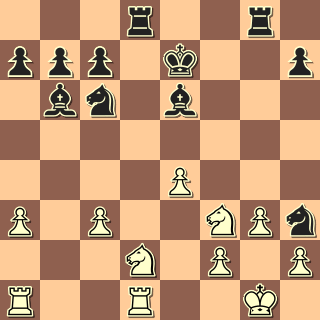majimba - perrypawnpusher
Chess.com Italian Game tournament, 2015
1.e4 e5 2.Nf3 Nc6 3.Bc4 Bc5 4.b4
The Evans Gambit.
4...Bxb4 5.c3 Ba5 6.0-0 d6 7.d4 Bb6
8.dxe5 dxe5 9.Bxf7+
Kapow! A Delayed Evans Jerome Gambit!
Where did my opponent get the idea? If I had to guess, I would say it could have been from an old post at Chess.com by someone called skiingisfun69 (I have edited lightly for clarity):
...Only played in one grandmaster game that I could find. Is this a mistake? If so, how? It appears that no matter what Black does, his position is completely losing...
I just played this on Yahoo chess against a friend, 7 minute / 7 second increments...I was very surprised to find out we had played grandmaster chess up until move 8. I had no idea there was such a thing as the Evans Gambit - I assumed my pawn sacrifice on b4 was no longer a standard line.
On move 9 in my game I played Bxf7+. Is this move a mistake? According to the Chess.com database, it was only played in one game. Grandmasters usually choose 9.Qb3 or 9.Qxd8. How are these moves better than 9.Bxf7+? I only found one game where 9.Bxf7+ was played http://www.chess.com/games/view.html?id=144868. White won quickly.
It appears to me that no matter what Black does, his position is clearly losing. If he doesn't take the bishop his position is losing. When I then offer the knight, if it he takes it he's simply down a queen for two minor pieces - losing. If he doesn't take it, he just loses.
What a discovery! Who wouldn't want to try out 9.Bxf7+?
9...Kxf7 10.Nxe5+ Ke8!
Not according to White's plan.
Painful for Black is 10...Ke6: 11.Qg4+ Kxe5 12.Bf4+ (12.Qf4+ Ke6 13.Qf5+ Ke7 14.Ba3+ Nb4 15.Bxb4+ c5 16.Bxc5+ Bxc5 17.Qxc5+ Kf7 18.Na3 Nf6 19.Nb5 Qe7 20.Nd6+ Kg6 21.e5 Rd8 22.Qe3 Ng8 23.Qd3+ Kh6 24.Nf7+ Qxf7 25.Qxd8 Qe6 26.Qh4+ Kg6 27.f4 Qb6+ 28.Kh1 h6 29.f5+ Kh7 30.Qe7 Black resigned, Wilson,P - Wilson,J, correspondence, 1921) 12...Kxe4 13.Re1+ Kd3 (13...Kd5 14.Qd1+ Nd4 15.Re5+ Kc4 16.Na3+ Black resigned, Ford,E - Vorrath,A, Manhattan Chess Club Handicap Tournament, New York, 1891) 14.Qe2 checkmate, skiingisfun69 - NN, 7 7 blitz, Yahoo Chess, 2008;
or 10...Kf8: 11.Ba3+ Nge7 12.Qf3+ Black resigned, Eckl,J - Schoenewald, correspondence, 1967.
But I was out to disappoint my opponent.
11.Qh5+ g6
12.Nxg6
Actually, better is 12.Nxc6 gxh5 13.Nxd8 Kxd8-+ 14.Bg5+ (14.Nd2 Nf6 15.e5 Ng4 16.Nc4 Be6 17.Nxb6 axb6 18.Bg5+ Kd7 19.a3 Ra5 20.f4 Rha8 21.f5 Bc4 22.e6+ Ke8 23.Rf4 Bd3 24.h3 Ne3 25.Rf3 Bxf5 26.Rxe3 Rxa3 27.Rxa3 Rxa3 28.e7 b5 29.Re5 Bd7 30.Re4 Ra1+ 31.Kf2 Ra2+ 32.Kg3 Bc6 33.Rf4 Rxg2+ 34.Kh4 Re2 35.Rf8+ Kd7 36.Rd8+ Ke6 37.e8Q+ Black resigned, Philidor 1792 - guest343, www.bereg.ru, 2013) 14...Ne7 15.Nd2 Rg8 16.Bh4 Bh3 17.Bg3 h4 White resigned, Girard - Corbat, IECC TH-T email 2000.
You might have noticed in the paragraph above that one of the games was played by Jerome Gambit Gemeinde member Philidor 1792. That is one reason to why majimba's Bishop sac wasn't a surprise to me.
Longtime Readers may remember that there were 4 posts to this blog on the "Delayed Evans Jerome Gambit" in October and November of 2013. That is another reason I was not fooled.
12...Nf6 13.Bg5
Overlooking my reply.
A stronger alternative, still giving Black the advantage, is 13.Qh6: 13...Rg8 14.Nh4 (14.Nf4 Ne5 15.Nd5 Rg6 16.Nxf6+ Qxf6 17.Qxh7 Bg4 18.Be3 Rd8 19.Nd2 Rd7 White resigned, Kurpnieks,V - Kovacs,A, LSS email, 2008) 14...Ne5 15.g3 Neg4 16.Qf4 Nh5 17.Qf3 Qxh4 White resigned, Kopel - Grocescu, correspondence, 1989.
13...Nxh5 14.Bxd8 Rg8
Black will remain two pieces up.
15.Nh4 Kxd8 16.Nd2 Be6 17.Rfd1 Ke7 18.a3 Rad8 19.Nhf3 Nf4 20.g3 Nh3+ White resigned
(My apologies to the Gemeinde, but a true Jerome Gambit player must know how to play against the gambit, too.)
.png)
.png)
.png)
.png)
.png)
.png)
No comments:
Post a Comment